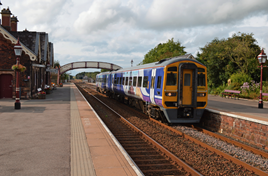Passengers were also now given two options: to connect with replacement bus services for the short eight-mile journey to Carlisle from the more northerly terminus of Armathwaite, or to switch at Appleby for direct bus services to Carlisle via Penrith and the M6. The introduction of heavily discounted Settle-Carlisle Day Ranger and Rail Rover tickets by Northern would also help contribute to a modest recovery in passenger numbers.
Unlike 1989, when the considerable cost of repairing Ribblehead Viaduct was used to justify full closure of the line, there was never any doubt that Network Rail would dig deep and fund the necessary repairs. In 2015 the S&C carried more passengers and freight than it had in several decades, and operated around the clock with more than 1.3 million passengers a year, eight daily passenger services in each direction and 40 available freight paths per day.
It offers an essential diversionary route for both the East Coast and West Coast Main Lines. And since the dark days of rationalisation and the ‘maintenance holidays’ of the 1980s, millions have been spent to double signalling capacity and renew track and infrastructure, put back removed loops, and increase the overall line speed to 60mph.
In July NR announced that it had finalised its repair solution, having carefully considered six potential options including a significant alteration to the course of the S&C, and even replacing the entire embankment at Eden Brows with a new viaduct.
At a cost of £23 million, engineers had decided to build a concrete slab 1.5 metres thick and 100 metres long, sitting just below the railway. It will be held in place by two rows of steel piles filled with concrete, driven up to 20 metres into the ground to anchor it firmly into the bedrock of the gorge. A further £5m earthworks project was also given the go-ahead, to re-profile the embankment and protect its base from further erosion by the River Eden.
Having appointed Story Contracting, NR then set out a comprehensive construction sequence. It expects the line to re-open in March 2017.
RAIL was invited to head north and view the works on August 31, traveling on the 1049 from Leeds.
The train sheds most of its passengers during station calls at the large commuter towns of Bingley and Keighley (it had only been a quarter full in the first place), and just 30 minutes into the journey, at the northwestern extremity of Leeds’ electrified Metro network at Skipton, only two of us are left in the carriage. The rain sets in and the gradients begin to get steeper, as the flat Aire Valley gives way to the rolling Yorkshire Dales - the first reminder of the harsh conditions faced by almost 6,000 navvies who toiled to build the S&C between 1869 and 1875.
At Settle, RAIL is joined by former Friends of the Settle-Carlisle Line (FoSCL) Chairman Mark Rand. Although another 20 or so passengers board here, Rand isn’t overly surprised by the lack of patronage on the four-car service. And neither is Northern guard Paul Charlesworth, as he makes another of his regular ticket inspections.
“We’re probably down by 60%-70% from normal. Quite often you would be standing at this time of year,” he tells RAIL. “It’s still the school holidays after all.
“But people don’t want to get on a bus, and that’s what it comes down to. When we were terminating at Appleby it took one hour and 20 minutes to get to Carlisle, and sometimes more. People were missing their connections to Glasgow and Edinburgh.
“It’s much better now we go up to Armathwaite, which is only about 30 minutes away. Or people can jump on the direct bus up the M6.”
Charlesworth adds: “With the cheaper Rover tickets, numbers have risen a little bit, making the most of the obvious magnificent views. And we’re still by far the cheapest way to get to Scotland.”
A quick calculation online shows this to be the case by some considerable margin, with a Leeds-Glasgow return costing £101.50 via any permitted route, and £55.90 if going via Appleby.
There are other encouraging signs that not all business has been lost since February. Just north of Settle we are passed by a southbound Class 66 hauling a train of empties from the British Gypsum facility at Kirkby Thore.
Moments later, just south of Horton-in-Ribblesdale, we pass GBRf 66779 Evening Star sitting in a siding at Arcow Quarry, at the head of a rake of ex-coal hoppers filled with aggregates. Reconnected to the S&C only late last year after losing its rail link in the 1960s, Arcow Quarry is a welcome sign that the S&C is once again generating home-grown freight traffic, even if it has lost its through flows for the time being.
Rand informs RAIL that a guided tour for a group of almost 50 tourists is taking place in the front coach, led by another member of FoSCL. Large bookings are happily still almost a daily occurrence - part closed or not, this line still has plenty to offer. He gives RAIL its own personal guided tour, and he goes into autopilot mode when we cross the mighty Ribblehead Viaduct.
Looking over the side, our attention is drawn to the faint grassy outlines of Navvy camps 100ft below, and named after Crimean War battlefields. It is a sobering thought that this is where 10% of the 2,000-strong workforce allocated to build this gargantuan structure succumbed to cholera, smallpox, or unfortunate industrial accidents caused by the newly discovered dynamite.
The commentary continues as we reach Dent, the highest main line station in England, and then Mallerstang signal box, where a signaller infamously played his part in causing the Ais Gill collision of 1913, in which 16 passengers perished.
















Login to comment
Comments
No comments have been made yet.